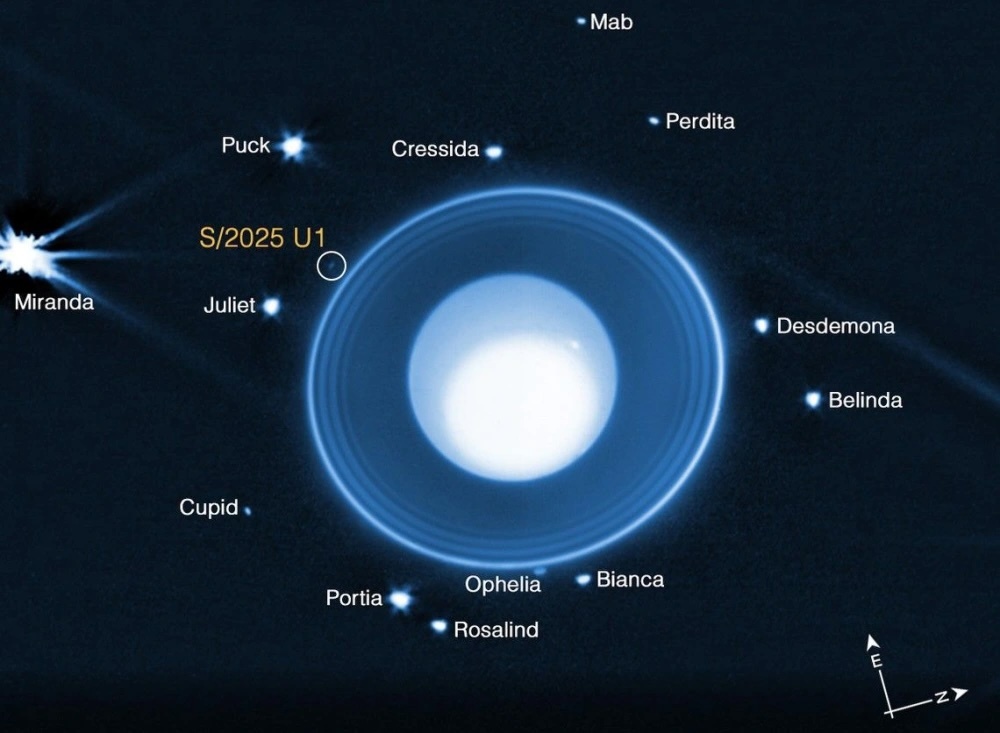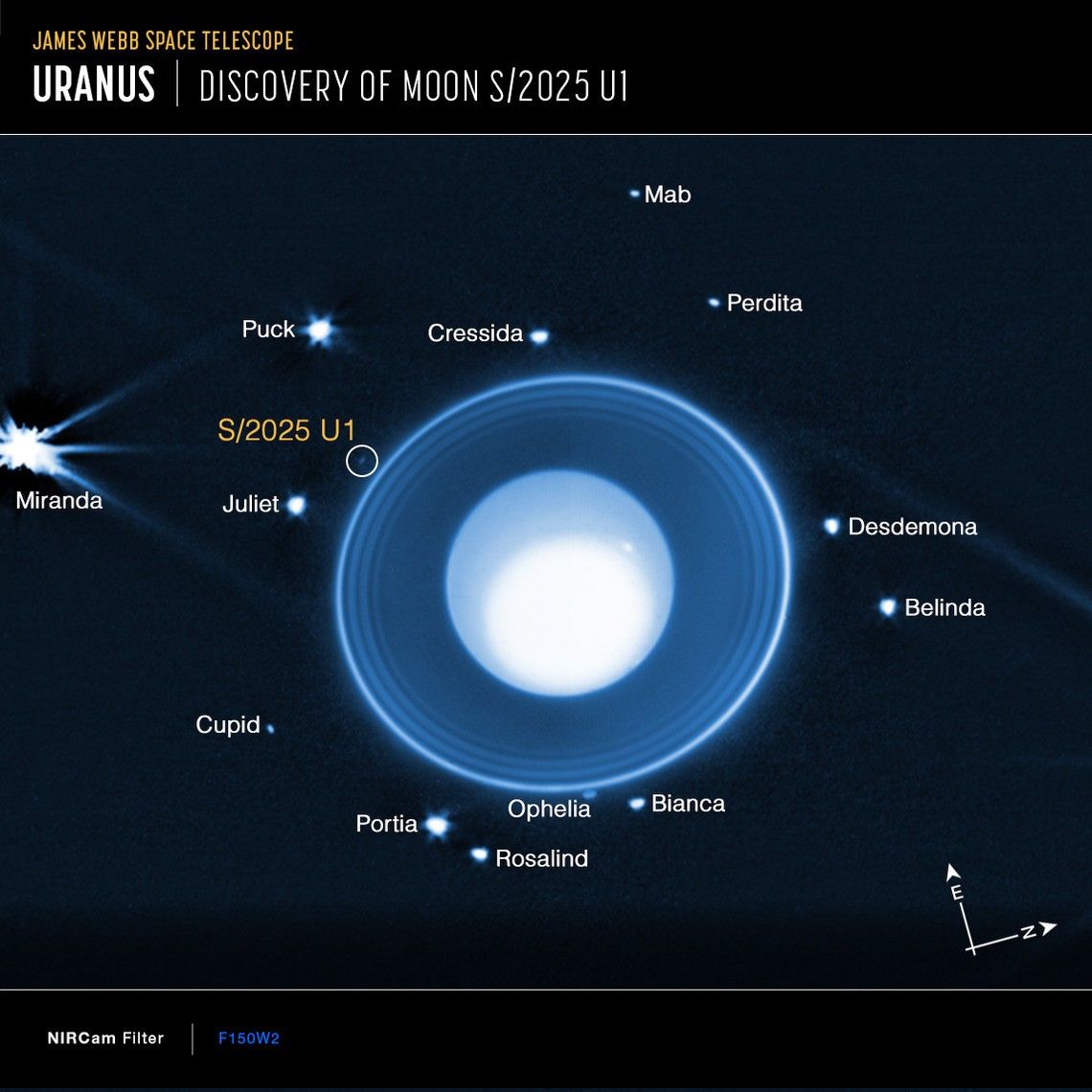21.08.2025
NASA's James Webb Space Telescope first detected Uranus' new moon this year.


Roll out the cosmic welcome mat for our solar system’s newest resident: a never-before-seen moon orbiting Uranus.
A team of astronomers announced Tuesday that a new satellite measuring roughly 90 football fields across was discovered around the seventh planet from the sun. The moon, which was first seen by NASA’s James Webb Space Telescope on Feb. 2, joins a busy neighborhood of 28 other known moons around Uranus.
The Webb telescope’s observations of Uranus are giving scientists better insight into one of the more mysterious planets in our solar system.
“No other planet has as many small inner moons as Uranus,” Matthew Tiscareno, a member of the research team and a senior research scientist at the SETI Institute in California, said in a statement.
Tiscareno said the “complex inter-relationships” between Uranus’ moons and its faint rings suggest the planet’s evolutionary history may have been a chaotic one.
“Moreover, the new moon is smaller and much fainter than the smallest of the previously known inner moons, making it likely that even more complexity remains to be discovered,” he said in the statement.
The newfound satellite is about 35,000 miles from the center of the planet, with a near circular orbit, according to the researchers.
It’s only about 6 miles across — a distance that can be walked in about two hours at a brisk pace — but follow-up observations are needed to confirm the moon’s size and other characteristics.
The discovery has also not yet been peer-reviewed.
Uranus has five large, outer moons named Miranda, Ariel, Umbriel, Titania and Oberon. The newly discovered moon is inside the orbits of the five larger moons, the researchers said.
All of Uranus’ moons are named after characters from the works ofShakespeare and Alexander Pope, according to NASA. The new moon does not yet have a name, though any designation will eventually need to be approved by the International Astronomical Union, which oversees the official naming process for astronomical objects.
“It’s a small moon but a significant discovery, which is something that even NASA’s Voyager 2 spacecraft didn’t see during its flyby nearly 40 years ago,” Maryame El Moutamid, a lead scientist in the Southwest Research Institute’s Solar System Science and Exploration Division, said in a statement.
In 1986, the Voyager 2 probe became the first human-made object to fly past Uranus, giving humanity its first close-up views of the distant planet. The historic encounter yielded more than 7,000 photographs of Uranus and helped scientists discover two new rings and 11 new moons around the planet.
The newest moon’s tiny size likely made it too small for Voyager 2’s cameras to see, but the Webb telescope’s high-resolution instruments may shed more light on the planet and its system.
“Looking forward, the discovery of this moon underscores how modern astronomy continues to build upon the legacy of missions like Voyager 2,” El Moutamid said in the statement. “Now, nearly four decades later, the James Webb Space Telescope is pushing that frontier even farther.”
Quelle: NBC News
+++
New Moon Discovered Orbiting Uranus Using NASA’s Webb Telescope
Using NASA’s James Webb Space Telescope, a team led by the Southwest Research Institute (SwRI) has identified a previously unknown moon orbiting Uranus, expanding the planet’s known satellite family to 29. The detection was made during a Webb observation Feb. 2, 2025.
“This object was spotted in a series of 10 40-minute long-exposure images captured by the Near-Infrared Camera (NIRCam),” said Maryame El Moutamid, a lead scientist in SwRI’s Solar System Science and Exploration Division based in Boulder, Colorado. “It’s a small moon but a significant discovery, which is something that even NASA’s Voyager 2 spacecraft didn’t see during its flyby nearly 40 years ago.”
NASA, ESA, CSA, STScI, M. El Moutamid (SwRI), M. Hedman (University of Idaho). Animation: J. DePasquale (STScI).
The newly discovered moon is estimated to be just six miles (10 kilometers) in diameter, assuming it has a similar reflectivity (albedo) to Uranus’ other small satellites. That tiny size likely rendered it invisible to Voyager 2 and other telescopes.
“No other planet has as many small inner moons as Uranus, and their complex inter-relationships with the rings hint at a chaotic history that blurs the boundary between a ring system and a system of moons,” said Matthew Tiscareno of the SETI Institute in Mountain View, California, a member of the research team. “Moreover, the new moon is smaller and much fainter than the smallest of the previously known inner moons, making it likely that even more complexity remains to be discovered.”

The new moon is the 14th member of the intricate system of small moons orbiting inward of the largest moons Miranda, Ariel, Umbriel, Titania, and Oberon. (All the moons of Uranus are named after characters from Shakespeare and Alexander Pope.)
“It’s located about 35,000 miles (56,000 kilometers) from Uranus’ center, orbiting the planet’s equatorial plane between the orbits of Ophelia (which is just outside of Uranus’ main ring system) and Bianca,” said El Moutamid. “Its nearly circular orbit suggests it may have formed near its current location.”
A name for the newly found moon will need to be approved by the International Astronomical Union (IAU), the leading authority in assigning official names and designations to astronomical objects.
“Through this and other programs, Webb is providing a new eye on the outer solar system. This discovery comes as part of Webb’s General Observer program, which allows scientists worldwide to propose investigations using the telescope’s cutting-edge instruments. The NIRCam instrument’s high resolution and infrared sensitivity make it especially adept at detecting faint, distant objects that were beyond the reach of previous observatories,” said El Moutamid. “Looking forward, the discovery of this moon underscores how modern astronomy continues to build upon the legacy of missions like Voyager 2, which flew past Uranus on Jan. 24, 1986, and gave humanity its first close-up look at this mysterious world. Now, nearly four decades later, the James Webb Space Telescope is pushing that frontier even farther.”
Quelle: NASA
